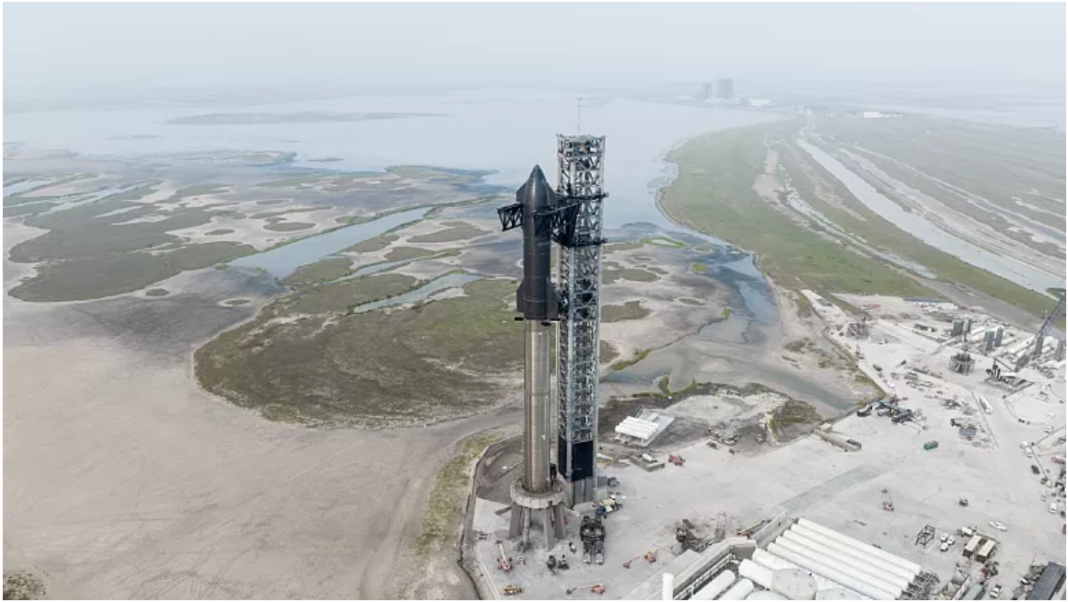Starship, the world’s biggest and mightiest rocket ever built, is set to lift off on Monday for the first time in a much-anticipated test flight.
Elon Musk and his company SpaceX hope the giant rocket will eventually shuttle people to the Moon and Mars.
Starship is set to blast off on Monday at 1 pm GMT (3 pm CET) with no one aboard. Musk’s company got the OK from the Federal Aviation Administration (FAA) on Friday.
It will be the first launch with Starship’s two sections together. Early versions of the sci-fi-looking upper stage rocketed several miles into the stratosphere, crashing four times before finally landing upright in 2021.
The towering first-stage rocket booster, dubbed Super Heavy, will soar for the first time.
For this demo, SpaceX won’t attempt any landings of the rocket or the spacecraft. Everything will fall into the sea.
“I’m not saying it will get to orbit, but I am guaranteeing excitement. It won’t be boring,” Musk promised at a Morgan Stanley conference last month.
“I think it’s got, I don’t know, hopefully about a 50 per cent chance of reaching orbit”.
How big is Starship?
Almost 120 metres tall, the stainless steel Starship has 33 main engines and 7.57 million kg of thrust. All but two of the methane-fuelled, first-stage engines ignited during a launch pad test in January – good enough to reach orbit, Musk said.
Given its muscle, Starship could lift as much as 227 tonnes and accommodate 100 people on a trip to Mars.
Starship easily eclipses NASA’s Moon rockets – the Saturn V from the bygone Apollo era and the Space Launch System (SLS) from the Artemis program that logged its first lunar trip late last year.
It also outflanks the former Soviet Union’s N1 Moon rocket, which never made it past a minute into flight, exploding with no one aboard.
Musk anticipates using Starship to launch satellites into low-Earth orbit, including his own Starlinks for internet service, before strapping anyone in.
Starship’s test flight
The test flight will last 1.5 hours, and fall short of a full orbit of Earth. If Starship reaches the three-minute mark after launch, the booster will be commanded to separate and fall into the Gulf of Mexico.
The spacecraft would continue eastward, passing over the Atlantic, Indian and Pacific oceans before ditching near Hawaii.
Musk said a key goal of the flight was to get the rocket a good distance from the launch site without a hitch.
“Just don’t blow up the launchpad,” he told Twitter users on Sunday.
Starship is designed to be fully reusable but nothing will be saved from the test flight. Harvard astrophysicist and spacecraft tracker Jonathan McDowell will be more excited whenever Starship actually lands and returns intact from orbit.
It will be “a profound development in spaceflight if and when Starship is debugged and operational,” he said.
Starship will take off from a remote site on the southernmost tip of Texas near Boca Chica Beach. Down the road from the launch pad is the complex where SpaceX has been developing and building Starship prototypes for the past several years.
The Texas launch pad is equipped with giant robotic arms – called chopsticks – to eventually grab a returning booster as it lands.
Shooting for the Moon
With Starship, the California-based SpaceX is focusing on the Moon for now, with a $3 billion (€2.7 billion) NASA contract to land astronauts on the lunar surface as early as 2025, using the upper-stage spacecraft.
It will be the first Moon landing by astronauts in more than 50 years. The moonwalkers will leave Earth via NASA’s Orion capsule and Space Launch System rocket, and then transfer to Starship in lunar orbit for the descent to the surface, and then back to Orion.
To reach the Moon and beyond, Starship will first need to refuel in low-Earth orbit. SpaceX envisions an orbiting depot with window-less Starships as tankers.
But Starship isn’t just for NASA. A private crew will be the first to fly Starship, orbiting Earth. Two private flights to the moon would follow – no landings, just flyarounds.











